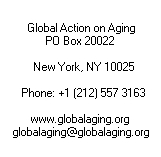
back

|
 |
JoinTogether.org
July 21, 2003
Alcohol and
other drug addiction among seniors is such a significant and growing
problem that one treatment expert called it "America's hidden
epidemic," UPI
reported July 16.
Carol Colleran,
national director of older-adult services at Hanley-Hazelden, a treatment
center in West Palm Beach, Fla., said at least 17 percent of Americans age
55 or older have either alcohol or drug problems, or both. However, she
said, very few seniors are in treatment programs, because their physicians
usually fail to diagnose the problem.
According to Colleran, about two-thirds of older Americans have alcoholism
that started before age 50. The remaining one-third developed late-onset
addictions, often arising from life changes such as retirement or death or
disability of a spouse.
"Our patients often tell me that their whole lives are about loss.
They are losing their hair, hearing, teeth, and eyesight and then they
lose loved ones and friends," Colleran said.
Often, these seniors are misdiagnosed as being depressed. But Colleran
said, "Once we get them through detox, the alcohol-induced depression
lifts and we can confirm that alcohol is the real problem."
According to the National Institute on Alcohol Abuse and Alcoholism, while
hospital admissions for alcohol-related problems are equal to those for
heart attacks among older Americans, physicians and nurses are
"significantly less likely to recognize alcoholism in an older
patient than in a younger patient."
Kristine Pringle, a doctoral student at Penn State University's school of
health policy and administration, said that Medicare records also show
that addiction among the elderly is under diagnosed.
"Several years ago we did a study with researchers at Columbia
University," Pringle said. "We interviewed 400 physicians and
tested them with a hypothetical case study of an elderly alcoholic. Less
than 1 percent of them mentioned alcohol."
Diagnosing drug addiction is just as difficult, because older Americans
usually don't use street drugs, but rather abuse their prescription
medications.
"The most common addiction is to benzodiazepines, tranquilizer drugs
like Valium and Xanax," Colleran said. "Valium was developed as
post-trauma medication to be used for 14 days. We have patients who have
been taking it for 20 to 25 years."
Noting that prevention is key to curbing addiction among the elderly,
Colleran said that Americans should include emotional planning in their
retirement preparation.
"We always hear about financial planning for retirement," she
said. "But I think that emotional planning is just as important. We
need to plan for ways to retain our sense of belonging and being needed by
others. An emotional retirement plan could go a long ways toward
preventing alcoholism and drug addiction among the elderly."
Copyright
© 2002 Global Action on Aging
Terms of Use | Privacy
Policy | Contact Us
|



